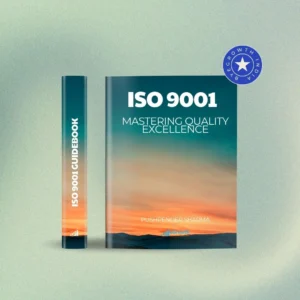No products added!
Category
Date Posted
February 13, 2024
/
ISO 9001 is an international standard for quality management systems (QMS) developed by the International Organization for Standardization (ISO). It is designed to help organizations of all sizes and industries to consistently provide products and services that meet customer needs and comply with regulations.
ISO 9001:2015 is provides a systematic approach to managing quality, with a focus on identifying and managing risks and opportunities, and continuously improving processes to enhance customer satisfaction and business performance. It is applicable to any organization, regardless of size or industry, and can be used by both product and service-oriented organizations to improve their quality performance, efficiency, and competitiveness.
"ISO 9001:2015: A universal standard for all organizations, regardless of size, industry, or location."
Versions of ISO 9001 :
The current revision of the ISO 9001 standard is ISO 9001:2015. It was published on September 23, 2015, and is the fifth revision of the ISO 9001 standard. The previous versions of ISO 9001 are,
Accumsan mass
Donec sit amet turpis tincidunt eros, nam porttitor massa leo porta maecenas reque.
Tesque ornare
Donec sit amet turpis tincidunt eros, nam porttitor massa leo porta maecenas reque.
Pharetra sit amet aliquam id diam maecenas. Dignissim suspendisse in est ante in nibh mauris cursus mattis. Pellentesque sit amet porttitor eget dolor morbi. Amet consectetur adipiscing elit duis tristique sollicitudin nibh. In vitae turpis massa sed elementum tempus egestas sed sed. Libero enim sed faucibus turpis in eu.
PDCA Cycle in ISO 9001:2015
The PDCA cycle is a continuous improvement model used in various quality management systems, including ISO 9001:2015. It stands for Plan-Do-Check-Act and is also known as the Deming Cycle, after its creator, Dr. W. Edwards Deming. The PDCA cycle is a fundamental tool in quality management that helps organizations improve their processes and products continually. This cycle can be applied to any process or system, including manufacturing, service delivery, and administrative processes.
1. Plan (P)
In this stage, the organization identifies the problem, sets goals, and develops a plan to achieve them. The planning stage is critical to the success of the cycle because it sets the foundation for the other stages.
2. Do (D)
In this stage, the organization implements the plan and carries out the activities necessary to achieve the goals set in the planning stage. This is the action phase of the cycle.
3. Check (C)
In this stage, the organization evaluates the results of the activities carried out in the “Do” stage. This evaluation is done using metrics or other forms of measurement to determine if the activities were successful in achieving the goals set in the planning stage.
4. Act (A)
In this stage, the organization takes action based on the results of the evaluation in the “Check” stage. If the goals were met, the organization can implement the changes on a larger scale. If the goals were not met, the organization will revise the plan and start the cycle again.
The PDCA cycle is a continuous process that organizations can use to improve their processes and products continually. Each cycle builds on the previous one, and the organization continues to refine and improve its processes over time.
We provide learning solutions that areresults-drivenandprioritise your educational objectives. We offer award-winningeducation that is 100% focused on results."
Tags :
851





Morbi tincidunt ornare massa eget egestas purus viverra. Eget est lorem ipsum dolor. Elit scelerisque mauris pellentesque pulvinar pellentesque habitant morbi.Sed ullamcorper morbi tincidunt ornare massa eget egestas purus viverra. Rutrum quisque non tellus orci ac auctor augue mauris.